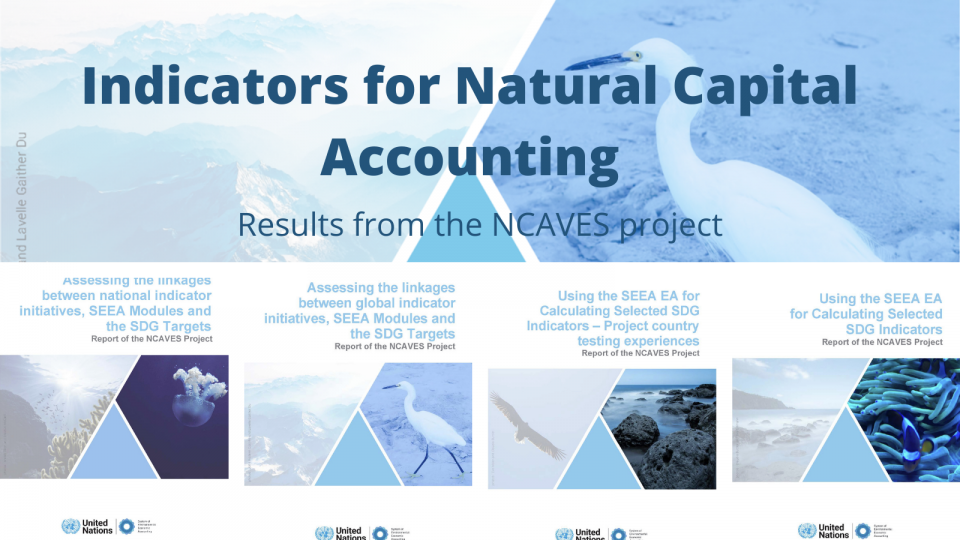UNSD releases final results of the NCAVES Indicators workstream

The indicators workstream of the Natural Capital Accounting and Valuation of Ecosystem Services (NCAVES) project set out to assess the potential of the SEEA Ecosystem Accounting (SEEA EA) to derive relevant indicators (global and national). The work on indicators for the NCAVES project was implemented in partnership with UNEP-WCMC.
Based on an initial assessment of the linkages of the SEEA EA to the existing global monitoring frameworks, such as those used for reporting on the Sustainable Development Goals (SDGs), the Aichi targets and emerging post-2020 Global Biodiversity Framework, as well as selected national indicator initiatives from the NCAVES countries, 4 indicators were selected during an expert meeting in 2019 for further testing. An important collective observation from the national assessments is that the different SEEA accounting modules can inform on a range of environmental policy objectives, themes, development perspectives and analytical objectives (including indicator gap analysis). To support the country testing, a set of technical notes were developed. These technical notes describe SEEA based approaches to calculate four of the global SDG indicators from the indicator framework developed by the Inter-Agency and Expert Group on SDG Indicators. The technical notes are in alignment with the methods described for calculating these global SDG indicators, as described in their associated metadata sheets.
The results of the testing have been summarized in a technical report entitled Using the SEEA EA for Calculating Selected SDG Indicators – Project country testing experiences. Most countries were able to generate a national version of SDG 15.1.1 (Forest area as a proportion of total land area), SDG 6.6.1 (Change in the extent of water-related ecosystems over time) and SDG 11.7.1 (Average share of the built-up area of cities that is open space for public use for all, by sex, age and persons with disabilities). In practice, calculating SDG 15.3.1 (Proportion of land that is degraded over total land area) was found to be more challenging, typically due to data constraints. However, the potential for the SEEA EA to support the generation of this indicator, in due course, was highlighted by the country testing.
An important insight from the testing is that there is often a need to tailor global SDG indicator methods to make the indicators meaningful to national circumstances. The flexible nature of the SEEA as an organising framework was highlighted in the testing as being very useful to aid calculating these nationally tailored SDG indicators in a rigorous and consistent manner. With regular updates, these can also be matched and integrated into different national policy cycles and planning strategies for various sectors. This will be key for fostering integrated policy making that is built on understanding of the interactions, synergies and trade-offs between the environment and economy. This is fundamental to informing sustainable development that proceeds in balance with nature.
The country testing and assessment concludes the NCAVES indicators workstream. However, with the SEEA EA adopted, work on indicators continues. Including on how the SEEA EA can support the needs of the emerging post-2020 biodiversity monitoring framework.
In summary, the indicators workstream has resulted in the following reports:
- Assessing the linkages between global indicator initiatives, SEEA Modules and the SDG Targets (2019): Presents an assessment of the potential to derive or align key global environmental and development indicators with the SEEA.
- Using the SEEA EA for Calculating Selected SDG Indicators (2020): Presents a series of Technical Notes to support the calculation of 4 priority SDG Indicators using the SEEA EA framework.
- Assessing the linkages between national indicator initiatives, SEEA Modules and the SDG Targets (2021): Presents an assessment of the potential to derive or align national indicator sets of the NCAVES countries with the SEEA.
- Using the SEEA EA for Calculating Selected SDG Indicators – Project country testing experiences (2021): Summarises the experiences of the NCAVES countries in evaluating and implementing these technical notes.
The NCAVES project is a joint initiative launched by the United Nations Statistics Division, the United Nations Environment Programme and the Secretariat of the Convention on Biological Diversity and funded by the European Union. NCAVES is working in collaboration with the five participating partner countries, namely Brazil, China, India, Mexico and South Africa, to advance the knowledge agenda on ecosystem accounting.
The reports and more information on the indicators workstream can be found at NCAVES page for Indicators : https://seea.un.org/content/indicators-and-natural-capital-accounting
